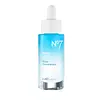What's inside
What's inside
 Key Ingredients
Key Ingredients

 Benefits
Benefits

 Concerns
Concerns

 Ingredients Side-by-side
Ingredients Side-by-side

Water
Skin ConditioningNiacinamide
SmoothingCetyl Alcohol
EmollientCaprylic/Capric Triglyceride
MaskingGlycerin
HumectantPropanediol
SolventIsononyl Isononanoate
EmollientJojoba Esters
EmollientPEG-20 Methyl Glucose Sesquistearate
EmulsifyingCetearyl Alcohol
EmollientDimethicone
EmollientMethyl Glucose Sesquistearate
EmollientAsparagopsis Armata Extract
Skin ProtectingCeramide NP
Skin ConditioningCeramide AP
Skin ConditioningPotassium Sorbate
PreservativeCeramide EOP
Skin ConditioningSorbitol
HumectantCarbomer
Emulsion StabilisingZinc Citrate
Behentrimonium Methosulfate
Triethanolamine
BufferingAloe Barbadensis Leaf Extract
EmollientSodium Lauroyl Lactylate
EmulsifyingSodium Hydroxide
BufferingEquisetum Arvense Extract
AstringentSodium Hyaluronate
HumectantCholesterol
EmollientPhenoxyethanol
PreservativePrunus Amygdalus Dulcis Oil
Skin ConditioningTocopherol
AntioxidantAscophyllum Nodosum Extract
Skin ConditioningLaureth-4
EmulsifyingHydrogenated Vegetable Oil
EmollientTetrasodium EDTA
Maltodextrin
AbsorbentPhytosphingosine
Skin ConditioningXanthan Gum
EmulsifyingButylene Glycol
HumectantEthylhexylglycerin
Skin ConditioningChrysanthellum Indicum Extract
Skin ConditioningWater, Niacinamide, Cetyl Alcohol, Caprylic/Capric Triglyceride, Glycerin, Propanediol, Isononyl Isononanoate, Jojoba Esters, PEG-20 Methyl Glucose Sesquistearate, Cetearyl Alcohol, Dimethicone, Methyl Glucose Sesquistearate, Asparagopsis Armata Extract, Ceramide NP, Ceramide AP, Potassium Sorbate, Ceramide EOP, Sorbitol, Carbomer, Zinc Citrate, Behentrimonium Methosulfate, Triethanolamine, Aloe Barbadensis Leaf Extract, Sodium Lauroyl Lactylate, Sodium Hydroxide, Equisetum Arvense Extract, Sodium Hyaluronate, Cholesterol, Phenoxyethanol, Prunus Amygdalus Dulcis Oil, Tocopherol, Ascophyllum Nodosum Extract, Laureth-4, Hydrogenated Vegetable Oil, Tetrasodium EDTA, Maltodextrin, Phytosphingosine, Xanthan Gum, Butylene Glycol, Ethylhexylglycerin, Chrysanthellum Indicum Extract
Water
Skin ConditioningGlycerin
HumectantPEG-40 Hydrogenated Castor Oil
EmulsifyingXylitylglucoside
HumectantPhenoxyethanol
PreservativeSodium Hyaluronate
HumectantPanthenol
Skin ConditioningAcrylates/C10-30 Alkyl Acrylate Crosspolymer
Emulsion StabilisingAnhydroxylitol
HumectantTocopheryl Acetate
AntioxidantCaprylyl Glycol
EmollientSodium Benzoate
MaskingXylitol
HumectantAscorbyl Glucoside
AntioxidantPropylene Glycol
HumectantPotassium Hydroxide
BufferingTetrasodium EDTA
Ethylhexylglycerin
Skin ConditioningParfum
MaskingGlucose
HumectantButylene Glycol
HumectantPanax Ginseng Root Extract
EmollientBiosaccharide Gum-4
Skin ConditioningDipropylene Glycol
HumectantMorus Alba Leaf Extract
Skin ConditioningWater, Glycerin, PEG-40 Hydrogenated Castor Oil, Xylitylglucoside, Phenoxyethanol, Sodium Hyaluronate, Panthenol, Acrylates/C10-30 Alkyl Acrylate Crosspolymer, Anhydroxylitol, Tocopheryl Acetate, Caprylyl Glycol, Sodium Benzoate, Xylitol, Ascorbyl Glucoside, Propylene Glycol, Potassium Hydroxide, Tetrasodium EDTA, Ethylhexylglycerin, Parfum, Glucose, Butylene Glycol, Panax Ginseng Root Extract, Biosaccharide Gum-4, Dipropylene Glycol, Morus Alba Leaf Extract
 Reviews
Reviews

Ingredients Explained
These ingredients are found in both products.
Ingredients higher up in an ingredient list are typically present in a larger amount.
Butylene Glycol (or BG) is used within cosmetic products for a few different reasons:
Overall, Butylene Glycol is a safe and well-rounded ingredient that works well with other ingredients.
Though this ingredient works well with most skin types, some people with sensitive skin may experience a reaction such as allergic rashes, closed comedones, or itchiness.
Learn more about Butylene GlycolEthylhexylglycerin (we can't pronounce this either) is commonly used as a preservative and skin softener. It is derived from glyceryl.
You might see Ethylhexylglycerin often paired with other preservatives such as phenoxyethanol. Ethylhexylglycerin has been found to increase the effectiveness of these other preservatives.
Glycerin is already naturally found in your skin. It helps moisturize and protect your skin.
A study from 2016 found glycerin to be more effective as a humectant than AHAs and hyaluronic acid.
As a humectant, it helps the skin stay hydrated by pulling moisture to your skin. The low molecular weight of glycerin allows it to pull moisture into the deeper layers of your skin.
Hydrated skin improves your skin barrier; Your skin barrier helps protect against irritants and bacteria.
Glycerin has also been found to have antimicrobial and antiviral properties. Due to these properties, glycerin is often used in wound and burn treatments.
In cosmetics, glycerin is usually derived from plants such as soybean or palm. However, it can also be sourced from animals, such as tallow or animal fat.
This ingredient is organic, colorless, odorless, and non-toxic.
Glycerin is the name for this ingredient in American English. British English uses Glycerol/Glycerine.
Learn more about GlycerinPhenoxyethanol is a preservative that has germicide, antimicrobial, and aromatic properties. Studies show that phenoxyethanol can prevent microbial growth. By itself, it has a scent that is similar to that of a rose.
It's often used in formulations along with Caprylyl Glycol to preserve the shelf life of products.
Sodium Hyaluronate is hyaluronic acid's salt form. It is commonly derived from the sodium salt of hyaluronic acid.
Like hyaluronic acid, it is great at holding water and acts as a humectant. This makes it a great skin hydrating ingredient.
Sodium Hyaluronate is naturally occurring in our bodies and is mostly found in eye fluid and joints.
These are some other common types of Hyaluronic Acid:
Learn more about Sodium HyaluronateTetrasodium EDTA is the salt formed from neutralizing ethylenediamine tetraacetic acid with sodium hydroxide. It is a chelating agent and used to prevent metal ions from binding to other ingredients. This helps keep the product and ingredients stable.
Tetrasodium EDTA comes as a white solid and is soluble in water.
Water. It's the most common cosmetic ingredient of all. You'll usually see it at the top of ingredient lists, meaning that it makes up the largest part of the product.
So why is it so popular? Water most often acts as a solvent - this means that it helps dissolve other ingredients into the formulation.
You'll also recognize water as that liquid we all need to stay alive. If you see this, drink a glass of water. Stay hydrated!
Learn more about Water